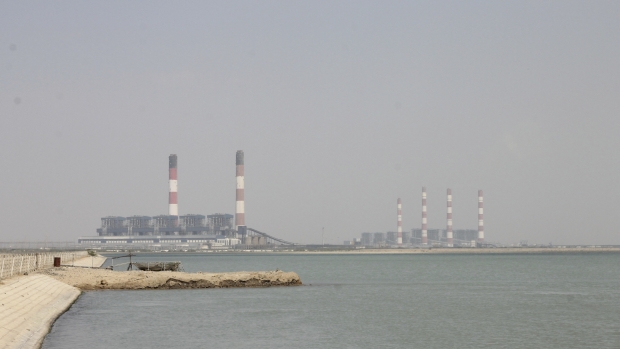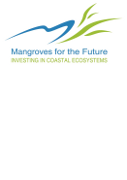Grants :: Small Grant Facilities :: Developing a practicable model through corporate-community participation for successful mangrove restoration activities in Kachchh, Gujarat
Developing a practicable model through corporate-community participation for successful mangrove restoration activities in Kachchh, Gujarat

CGPL will work with GUIDE and local communities to restore m ... , Mundra, Gujarat © MFF India, 2014
Objectives
The objectives of the project are as follows:
- Key stakeholders of mangrove habitats in Kachchh are empowered in sustainable mangrove management
- Post plantation maintenance and resource utilization is taken care of by villagers
- Awareness is generated and capacity is built among coastal communities on climate change and carbon economics potential of enhanced mangrove cover.
Background
Mangroves are among the most carbon-rich forests, thus carbon credit systems may offer the opportunity to achieve dual goals of poverty reduction and protection of marine carbon sinks. Kachchh coast in Gujarat has become a zone for intensive industrial development. With massive coastal industrial development, already reeling under recurrent drought and poor rainfall and land degradation underlines the need to protect and conserve coastal environment. There exist many ecological and technological lacunae in mangrove restoration activities planned in Kachchh coast. Lack of technically skilled work force available for plantation by industries, least involvement of local community and proper guidance from mangrove field biologist has led to failure of many projects. We recognize that communities are seeking ways to generate cash from mangrove forest and other natural resources so, how they can generate alternative livelihood by planting and conserving mangroves. Character of our proposed practicable model is to involve all stakeholders including community, industries and scientific organizations to ensure long term mangrove management and conservation. Proposed model targets long term conservation and management of mangroves by training local community, creating skilled local work force as a village level community based organization (CBO) and developing economic opportunities in the current scenario. Model will help in capacity building and awareness generation among locals for technically sound in plantation, post plantation care, climate change and carbon economics potential of mangroves. The key deliverables of the project are formation of a duly registered CBO with the government agency with elected office bearers to manage the activities of the CBO for mangrove conservation. There will be a facilitating agreement between industry and CBO for mangrove plantation in a specified area and its post plantation care. A well prepared plan by CBO for mangrove plantation approved by industry will be carried out and plantation site will be protected (with survival rate of 70-80% maintained for two years) from any sort of damage. Deliverables also include training awareness generation among locals for mangrove plantation, climate change, REDD, REDD+ and economic potential of carbon sequestered by mangroves
Target beneficiaries
Coasta Gujarat Power Limited (CGPL), TATA
Local Community from Mundra
Outputs
An understanding of corporate-community based mangrove restoration in the Gulf of Kachchh
Accomplishments and challenges
Though many of the coastal industries of Gulf of Kachchh are located among or in close vicinity of mangroves, awareness among corporate managers on the ecological significance of mangroves is poor. Through series of five workshops on different aspects of mangrove ecology corporate’s awareness increased manifold on different ecological and economic services of mangroves along with carbon credit, carbon trading and how mangrove plantation contributes to REDD+. Coastal industries of Gulf of Kachchh now appreciate the significance of conserving mangroves. These workshops have given a good opportunity to appreciate the
mindset of coastal industries with regard to mangrove plantation.
Majority of the industries are reluctant to involve nearby stakeholder communities in their mangrove plantation due to various administrative, social and managerial
reasons. As a case in point, the partnering industry in this project (CGPL) initially opined that CBO may not be adequately accountable for the responsibility entrusted which may ultimately fail to yield the desired result. Continued engagement with the coastal industry and further motivation in subsequent workshops brought about a perceptible change in the industry mindset who finally consented to handover mangrove plantation to trained and organised village communities. The stakeholder industry signed an MoU to this effect.
In all the conducted workshops a constructive dialogue on creation of a common platform for coastal industries of Gulf of Kachchh was mooted and seriously
discussed. This association will solely work for long term mangrove conservation in Gulf of Kachchh in association with communities. Creation of a common fund and charting out its objectives and aims were also discussed in detail. This lead is to be followed further
Two village communities, Modhva and Tragadi are now well trained in different aspects of mangrove plantation such as mangrove seed collection, treatment, site
selection for nursery and plantation and post plantation care. This will enable them to eke out a livelihood as they are fully equipped to take up mangrove plantation for any coastal industries of Gulf of Kachchh. In short, two well trained work forces who can take up and manage mangrove plantation on long term basis is in place
One major achievement was activation of the defunct Dharia Vikas Samiti (Coastal Area Committee) in Modhva village in order to manage all project related activities and to execute mangrove plantation (Annexure 10). Office bearers of this committee were trained on different functions of the committee including fund management. Regular functioning of the committee with good participation of village women enabled to keep the enthusiasm of villagers alive towards mangrove
plantation/conservation activities.
Mangrove plantation to the extent of ten (10 ha) is created by the village community with the financial support of coastal industry (Coastal Gujarat Power Ltd- TATA
Power)
Since the inception of the project during December 2013, fifteen awareness programs have been conducted for Modhva and nearby Tragadi village communities. These awareness programs significantly contributed to inculcate better knowledge on different ecological and economic significance of mangroves.
Being a fishing community, the target villagers have an implicit knowledge about mangroves and its benefits to fisheries and coastal protection. These awareness
programs further refined their understanding of mangroves and infused interest to take part in the project activities with more commitment and involvement. Basic
understanding of mangroves’ role as carbon sink and the potentials of carbon trading is further created among target villagers.
As a part of the project activity, attempts were made to obtain permission to carry out plantation in a revenue land falling within the boundary of Tragadi village. The
implementing agency (GUIDE) in the process of obtaining permission learnt the government formalities to acquire land from revenue department and various
bottlenecks and problems involved in this activity.This exposure to different government formalities to procure land will be quite useful to the implementing agency in its future activities.
While executing various plantation activities it was learnt that there is no manuals/handbooks for mangrove plantation/restoration and rehabilitation for
Gujarat and specifically for Gulf of Kachchh. This prompted the project in Charge to prepare a manual for mangrove plantation specifically for Gulf of Kachchh
region.
Contributions to cross-cutting themes
The importance of mangroves in disaster reduction, and as carbon stores is receiving increasing attention, particularly amongst the private sector.
Lessons Learned
GUIDE and IUCN facilitate dialogue platforms and interactions between communities and private sector companies in order that they form a relationship to work together on mangrove conservation and restoration in the future. However, it was quickly realised that neither the communities nor private sector entities were comfortable directly interacting with each other, and preferred having either GUIDE or NGO, or some other community based organisation as an intermediary. This was not initially considered when formulating the exit strategy for this project.
Project Facts
Country
Location
Mundra, Bhuj, Gujarat
Topic
- Capacity Building
- Civil Society Engagement
- Integrated Coastal Planning
- Strategies for Management
- Sustainable Business Practices
Duration
10th Dec 2013 to 10th Jun 2015
MFF Grant Amount
INR 1,138,500
Co-financing Partner
GUIDE: INR 113,500
Implementing Partner
Dr. G. A. Thivakaran,
Senior Principal Scientist, Gujarat Institute of Desert Ecology (GUIDE)
Email: athivakaran028@gmail.com
Related Publications

Developing a practicable model through corporate-community participation for successful Mangrove restoration activities in Kachchh, Gujarat
Author: GUIDE
Publisher: IUCN
Posted on: 12th May 2016
Category: SGF (Small Grant Facility)
Size: 1.1 MB